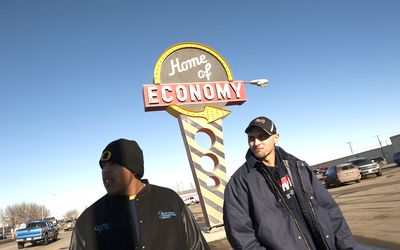Workers bear brunt of rate hikes
by Joseph Stiglitz,
2015-09-09 06:24:52.0
AT THE end of every August, central bankers and financiers from around the world meet in Jackson Hole, Wyoming, for the US Federal Reserve’s (Fed’s) economic symposium. This year, the participants were greeted by a large group of mostly young people including many African and Hispanic Americans.
They wanted the policy makers to know that their decisions affect ordinary people, not just the financiers who are worried about what inflation does to the value of their bonds or what interest rate hikes might do to their stock portfolios. Seven years after the global financial crisis triggered the Great Recession, the "official" unemployment among African-Americans is above 9%.
According to a broader definition, which includes part-time employees seeking full-time jobs and marginally employed workers, the unemployment rate for the US is 10.3%. But, for African-Americans, the rate is higher. For example, for African-Americans aged 17-20 who have graduated from high school but not enrolled in college, the unemployment rate is more than 50%.
With so many people out of work, downward pressure on wages is showing up in official statistics as well. So far this year, real wages for nonsupervisory workers fell nearly 0.5%. This is part of a long-term trend that explains why household incomes in the middle of the distribution are lower than they were 25 years ago. Wage stagnation also helps to explain why statements from Fed officials that the economy has virtually returned to normal are met with derision.
Perhaps it is true in neighbourhoods where the officials live. But, with the bulk of income increases since the US "recovery" began going to the top 1% of earners, it is not true for most communities.
The Fed has a dual mandate — to promote full employment and price stability. It has been more than successful at the second, partly because it has been less than successful at the first. So why will policy makers be considering an interest-rate hike at the Fed’s meeting this month?
The usual argument for raising rates is to damp an overheating economy in which inflationary pressures have become too high. Inflation hawks argue that the inflation dragon must be slayed before one sees the whites of its eyes. But now higher inflation would be good for the economy. There is no risk that the economy would overheat so quickly that the Fed could not intervene in time to prevent excessive inflation. If the Fed focuses excessively on inflation, it worsens inequality, which in turn worsens economic performance. Wages falter in recessions; if the Fed then raises rates every time there is a sign of wage growth, workers’ share will never recover what was lost in the downturn.
The argument for raising interest rates focuses not on the wellbeing of workers, but that of the financiers. The worry is that in a low-interest-rate environment, investors’ irrational "search for yield" fuels financial-sector distortions. In a well-functioning economy, one would have expected the low cost of capital to be the basis of growth. In the US, workers are being asked to sacrifice their livelihoods and wellbeing to protect well-heeled financiers from the consequences of their own recklessness.
The Fed should simultaneously stimulate the economy and tame the markets. Good regulation should adopt and enforce rules that restrict the flow of funds into speculation and encourage the financial sector to provide capital for new firms and enable successful firms to grow.
I often feel a great deal of sympathy for Fed officials, because they must make close calls in an environment of uncertainty.
But the call right now is not a close one — it is a no-brainer. Now is not the time to tighten credit and slow down the economy.
© Project Syndicate, 2015. www.project-syndicate.org.
• Stiglitz is a professor at Columbia University

Among African-Americans aged 17-20 years old, who have graduated from high school but not enrolled in college, unemployment is more than 50%. Income rises since the US ‘recovery’ began go to the top 1% of earners. Picture: REUTERS/ANDREW CULLEN
AT THE end of every August, central bankers and financiers from around the world meet in Jackson Hole, Wyoming, for the US Federal Reserve’s (Fed’s) economic symposium. This year, the participants were greeted by a large group of mostly young people including many African and Hispanic Americans.
They wanted the policy makers to know that their decisions affect ordinary people, not just the financiers who are worried about what inflation does to the value of their bonds or what interest rate hikes might do to their stock portfolios. Seven years after the global financial crisis triggered the Great Recession, the "official" unemployment among African-Americans is above 9%.
According to a broader definition, which includes part-time employees seeking full-time jobs and marginally employed workers, the unemployment rate for the US is 10.3%. But, for African-Americans, the rate is higher. For example, for African-Americans aged 17-20 who have graduated from high school but not enrolled in college, the unemployment rate is more than 50%.
With so many people out of work, downward pressure on wages is showing up in official statistics as well. So far this year, real wages for nonsupervisory workers fell nearly 0.5%. This is part of a long-term trend that explains why household incomes in the middle of the distribution are lower than they were 25 years ago. Wage stagnation also helps to explain why statements from Fed officials that the economy has virtually returned to normal are met with derision.
Perhaps it is true in neighbourhoods where the officials live. But, with the bulk of income increases since the US "recovery" began going to the top 1% of earners, it is not true for most communities.
The Fed has a dual mandate — to promote full employment and price stability. It has been more than successful at the second, partly because it has been less than successful at the first. So why will policy makers be considering an interest-rate hike at the Fed’s meeting this month?
The usual argument for raising rates is to damp an overheating economy in which inflationary pressures have become too high. Inflation hawks argue that the inflation dragon must be slayed before one sees the whites of its eyes. But now higher inflation would be good for the economy. There is no risk that the economy would overheat so quickly that the Fed could not intervene in time to prevent excessive inflation. If the Fed focuses excessively on inflation, it worsens inequality, which in turn worsens economic performance. Wages falter in recessions; if the Fed then raises rates every time there is a sign of wage growth, workers’ share will never recover what was lost in the downturn.
The argument for raising interest rates focuses not on the wellbeing of workers, but that of the financiers. The worry is that in a low-interest-rate environment, investors’ irrational "search for yield" fuels financial-sector distortions. In a well-functioning economy, one would have expected the low cost of capital to be the basis of growth. In the US, workers are being asked to sacrifice their livelihoods and wellbeing to protect well-heeled financiers from the consequences of their own recklessness.
The Fed should simultaneously stimulate the economy and tame the markets. Good regulation should adopt and enforce rules that restrict the flow of funds into speculation and encourage the financial sector to provide capital for new firms and enable successful firms to grow.
I often feel a great deal of sympathy for Fed officials, because they must make close calls in an environment of uncertainty.
But the call right now is not a close one — it is a no-brainer. Now is not the time to tighten credit and slow down the economy.
© Project Syndicate, 2015. www.project-syndicate.org.
• Stiglitz is a professor at Columbia University



























